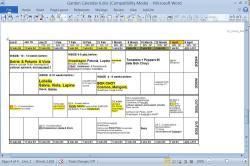I think that all published guidelines on seed packets, and advisory calenders, give us starting points. Depending on soil temperature and daylength at our latitude and exposure and micro-climate, and how rapidly or erratically temperatures rise in spring, we have to learn the magic dates for our backyards.
Counties and ZIP codes are too coarse, and "last frost date" is too simple to give universal hard-and-fast rules for every crop in every location.
But probably counting back or forward from 'average last spring frost date" or "average first fall frost date" gives us the right answer for many crops, and is within a month for all crops.
But the generic formulas probably won't tell us "that would be a better FALL crop in your micro-climate".
One thing that I did was to make up a long table in a Microsoft Word doc, with one week for each row. Then I filled in columns for dates, "weeks before average last frost", and "days before average last frost".
Then I added columns for the daily low temperatures 24F, 28F, 32F and 36F. I found some website (probably NOAA) that gave me statistics for the last 20 or 50 years for a nearby weather station.
I think that "28F" corresponds to a very hard frost, or a hard freeze.
32F corresponds to a frost, perhaps a light frost.
The % rows reflect how likely it is that weather will go lower than that temperature on that date or later.
So a "10%" means that it is very unlikely to go colder than that, so late in the year.
A "50%" shows the date where, in an average year, the weather will go no colder/
Thus the "32 F" column and the "50%" row in that column shows the average last "frost" date (assuming that "frost" means the weather got as cold as 32, or colder, for at least a few minutes, on that date or later.
The purpose of all this typing was to let me read some seed packet that says "start indoors 6-8 weeks before last spring frost", I can decide how pessimistic or ambitious to be, and then look up those dates in my table.
Sometimes I'm cautious, like when trying a crop for the first time.
Sometimes I push it, for example I don't have as long a warm season as tomatoes prefer, so I have to push them and then baby them if get a cold snap.
In theory, I would then keep notes on whether my first attempt for that crop was late enough, or too early, or so late that summer heat suppressed my "cold weather crops".
In practice, I don't keep good notes! You'll do much better than me if you keep track not so much of when other people recommend that you start each crop, but instead record when YOU sowed each crop, and how it turned out.
